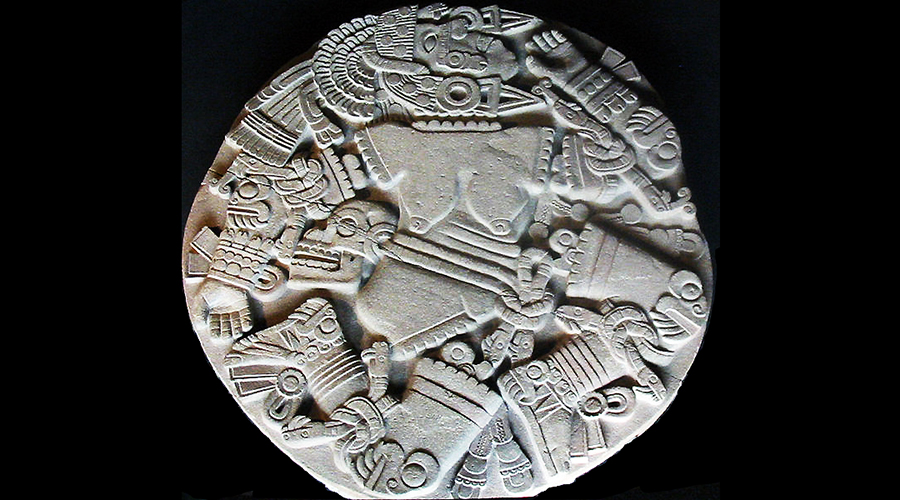Templo Mayor (Main Temple)
Templo Mayor (Main Temple). Tenochtitlan (modern Mexico City, Mexico). Mexica (Aztec). 1375–1520 C.E. Stone (temple); volcanic stone (The Coyolxauhqui Stone); jadeite (Olmec-style mask); basalt (Calendar Stone).
- Destroyed by the Spaniards
- Aztec temple devoted to two main deities: Huitzilopochtli (God of War/Sun) and Tlaloc (Rain/Agriculture)
- Center, surrounded by many other temples; modern Mexico city is consists of complicated layers of colonial and pre-colonial history
- Located in the sacred precinct at the heart of the city, the Templo Mayor was positioned at the center of the Mexica capital and thus the entire empire.
- The capital was also divided into four main quadrants, with the Templo Mayor at the center. This design reflects the Mexica cosmos, which was believed to be composed of four parts structured around the navel of the universe, or the axis mundi.
- Two grand staircases accessed twin temples, which were dedicated to the deities Tlaloc and Huitzilopochti. Tlaloc was the deity of water and rain and was associated with agricultural fertility. Huitzilopochtli was the patron deity of the Mexica, and he was associated with warfare, fire, and the Sun.
- The two deities symbolized the Mexica concept of atl-tlachinolli, or burnt water, which connoted warfare—the primary way in which the Mexica acquired their power and wealth; sacrifices.
The Coyolxauhqui Stone
- finely carved stone monolith that displayed a dismembered and decapitated woman
- Mexica (Aztec) goddess Coyolxauhqui attempted to kill her mother after becoming pregnant; her brother interfered and killed her. Beheaded her and threw her body down the mountain, at which point her body broke apart.
- Golden bells decorate her cheeks, feathers and balls of down adorn her hair, and she wears elaborate earrings, fanciful sandals and bracelets, and a serpent belt with a skull attached at the back. Monster faces are found at her joints.
- Coyolxauhqui is shown naked, with sagging breasts and a stretched belly to indicate that she was a mother. For the Mexica, nakedness was considered a form of humiliation and also defeat. She is also decapitated and dismembered. Her head and limbs are separated from her torso and are organized in a pinwheel shape. Pieces of bone stick out from her limbs.
- Temple dedicated to the born child; symbolically represented Coatepec.
- Enormous stone monolith; prominent figure in Aztec culture; protruding bones coming out of her legs; dismembered, decapitated; nudity was problematic; highly decorated
- Temple a symbolic representation of where Coyolxauhqui was thrown; chaotic movement;
Olmec-style mask
- Over a hundred ritual caches or deposits containing thousands of objects have been found associated with the Templo Mayor. Some offerings contained items related to water, like coral, shells, crocodile skeletons, and vessels depicting Tlaloc. Other deposits related to warfare and sacrifice, containing items like human skull masks with obsidian blade tongues and noses and sacrificial knives.
- The Olmec mask was made over a thousand years prior to the Mexica, and its burial in Templo Mayor suggests that the Mexica found it precious and perhaps historically significant.
- Older than the Aztecs, belongs to Olmec culture, more than 1500 yrs before the Aztecs; cleft in the head; ritually buried; Aztecs had reverence for the cultures before them; vast trade networks through Mesoamerica, would get pieces from all over Mexico/America
Calendar Stone
- Modern day emblem of Mexican culture; complicated; unfinished; uncharted rock; probably sun god, Tonatiuh; origin of the cosmics; creation
- Four cardinal directions; sun rays; organisation of the universe; shows structure;



